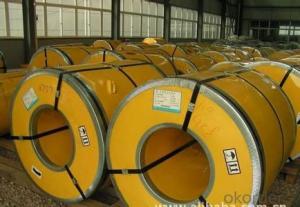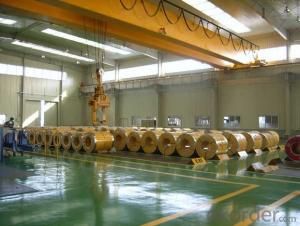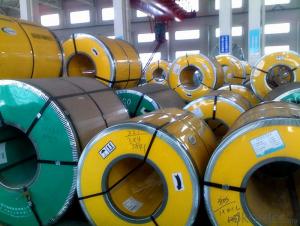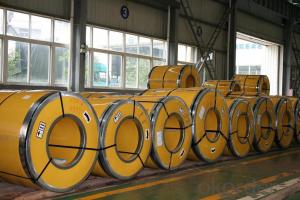Stainless Steel Coil Cold Rolled 201 Half Hard Surface No.2E with Best Quality
- Loading Port:
- Shanghai
- Payment Terms:
- TT OR LC
- Min Order Qty:
- 20 m.t.
- Supply Capability:
- 5000 m.t./month
OKorder Service Pledge
OKorder Financial Service
You Might Also Like
Item specifice
1. Structure of Stainless Steel Coil Cold Rolled 201 Descriptions
Stainless Steel 201 is a new kind of Austenite stainless steel by used Mn, N replace Ni.
The steel has good corrosion resistance and hot / cold processing performance, instead
of 304 stainless steel products for used in the not high of corrosive environment, such as
indoor, inland city outdoor etc.
2. Main Features of the Stainless Steel Coil Cold Rolled 201
Product name: Stainless Steel Coil Cold Rolled 201
Thickness: 0.2mm to 1.5mm
Technical: Cold Rolled
Width: 10mm to 1240mm
Type: 200 Series
Length: As customer's requested
Standard: JIS, SUS, AISI, ASTM
Grade: 201-J1, 201-J4, AISI201, AISI202…
Finish: BA, 2B, 8K, NO.3, NO.4, HL…
MOQ: 25 Metric Tons
Hardness: Low Hard(190 HV Max); Half Hard(240-280HV); Full Hard(42-60 HRC)
Ship Term: FOB any port, China or CFR Destination port
Delivery Time: 15 to 20 day after the receive the deposit or 100%LC
Payment Terms: TT 30% for deposit, Balance against the copy of B/L, or 100%LC
Packaging: By wooden pallet, wooden case or according to customer's request
3. Stainless Steel Coil Cold Rolled 201 Images

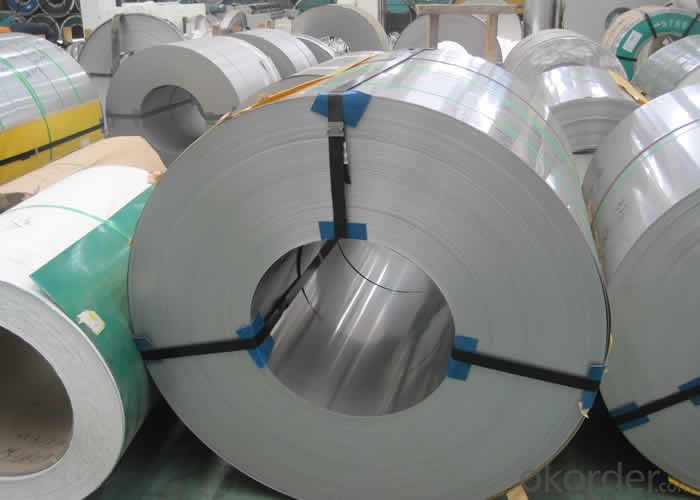
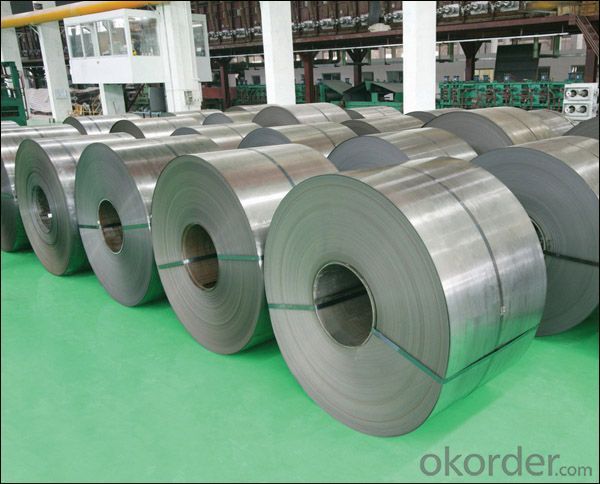
4. Stainless Steel Coil Cold Rolled 201 Specifications
Stainless Steel 200 Series Chemicals Contrast (wt. %) | ||||||||
Chemicals | C | Si | Mn | Cr | Ni | N | Other | |
205 | 0.12-0.25 | ≤0.75 | 14.0-15.0 | 16.5-18.0 | 1.0-1.75 | 0.32-0.4 | ||
JIS, | 201 | ≤0.15 | ≤1.0 | 5.5-7.5 | 16.0-18.0 | 3.5-5.5 | ≤0.25 | - |
201L | ≤0.03 | ≤0.75 | 5.5-7.5 | 16.0-18.0 | 3.5-5.5 | ≤0.25 | - | |
202 | ≤0.15 | ≤1.0 | 7.5-10.0 | 17.0-19.0 | 4.0-6.0 | ≤0.25 | - | |
201LN | ≤0.03 | ≤0.75 | 6.4-7.5 | 16.0-17.5 | 4.0-5.5 | 0.1-0.25 | Cu≤1.0 | |
India | 201-J1 | ≤0.08 | ≤0.75 | 7.0-8.0 | 15.0-17.0 | 4.0-5.0 | ≤0.1 | Cu≤1.5 |
201-J3 | ≤0.08 | ≤0.75 | 9.0-10.5 | 14.0-16.0 | 2.0-3.0 | ≤0.15 | Cu≤2.0 | |
201-J4 | ≤0.10 | ≤0.75 | 8.5-10.0 | 15.0-16.0 | ≤1.2 | ≤0.2 | Cu≤2.0 | |
America | 204 | ≤0.03 | ≤1.0 | 7.0-9.0 | 15.0-17.0 | 1.5-3.0 | 0.15-0.3 | (Cu) |
H400 | ≤0.10 | ≤1.0 | 6.0-9.0 | 17.0-19.5 | ≤3.5 | ≤0.3 | - | |
Japan | YUS130S | 0.09 | 0.5 | 11.0 | 18.0 | 6.5 | 0.35 | - |
NTK S-4 | 0.17 | 0.43 | 14.7 | 17.7 | 1.3 | 0.35 | - | |
NM15M | 0.08 | 0.8 | 14.5 | 17.0 | 4.3 | 0.33 | - | |
Europe America | 219 | ≤0.04 | ≤0.75 | 8.0-10.0 | 19.0-21.5 | 5.5-7.5 | 0.15-0.4 | - |
Cromanite | ≤0.08 | ≤1.0 | 9.5-11.0 | 18.0-20.0 | ≤1.0 | 0.4-0.6 | - | |
201 Surface | Characteristic and Application of Stainless Steel Coil Cold Rolled 201 |
2B | The surface brightness and flatness of 2B is better than 2D then through a special surface treatment to improve its mechanical properties,2B could nearly Satisfy comprehensive uses |
No.4 | Polished with abrasive belt of grit#150#180, have better brightness with discontinuous coarse stria, but thinner than NO.3, are used as bathtub buildings inner and electrical appliances kitchen utensils and food processing. |
BA | Cold rolled, bright annealed and skin-passed, the product have excellent brightness like mirror kitchen apparatus, etc. |
8K | The product have excellent brightness and prefer bright can be the mirror. |
5. FAQ of Stainless Steel Coil Cold Rolled 201
Q: Are you factory or trader?
A: We certainly are stainless steel manufacturer and have processing plant.
Q: Can you provide mill test certificate?
A: Yes! Mill test certificate for both hot rolled raw material coils and cold rolled coils are
available.
Q: Can you make DDQ (Deep drawing quality)?
A: Yes. Our material has been widely used for producing stainless steel pots and stainles
s steel sinks, which have strict request for good deep drawing quality.
Q: How to visit your factory?
A: Most of the main cities in the world have flight to Beijing; you can take flight to Beijing
first, then we will lead you to our Wuxi mills.
Q: How about your company?
A world class manufacturer & supplier of castings forging in stainless steel, is one of the
large-scale professional investment casting production bases in China, consisting of both
casting foundry forging and machining factory. Annually more than 90000 tons Precision
casting and forging parts are exported to markets in Europe, America and Japan. OEM
casting and forging service are available, all according to customer’s requirements.
Q: How to guarantee the quality of the products?
A: We have established the international advanced quality management system,every
link from raw material to final product we have strict quality test; We resolutely put an end
to unqualified products flowing into the market. At the same time, we will provide
necessary follow-up service assurance.
Q: How is the packaging and delivery?
A: Standard export packing (Coil: waterproof paper + protective steel ring; Circle: wooden
box), or as your requirement and the delivery term is based on the project.
Q: How long can we receive the product after purchase?
A: In the purchase of product within 20 working days, we will arrange the factory delivery
as soon as possible. The specific time of receiving is related to the state and position of
customers. Commonly 20 to 40 working days can be served.
- Q:Are stainless steel strips resistant to chlorine corrosion?
- Yes, stainless steel strips are generally resistant to chlorine corrosion. Stainless steel is known for its high resistance to corrosion and staining, which makes it an ideal material for various applications that come into contact with chlorine, such as swimming pool equipment, water treatment plants, and chemical processing facilities. The addition of elements like chromium and nickel in stainless steel enhances its corrosion resistance, forming a passive oxide layer on the surface that protects the metal from the harmful effects of chlorine. However, it is important to note that the corrosion resistance of stainless steel can vary depending on the specific grade and composition of the alloy, as well as the concentration and temperature of the chlorine solution. Therefore, it is recommended to consult with a stainless steel expert or refer to the specific corrosion resistance charts provided by stainless steel manufacturers to ensure the suitability of stainless steel strips in a chlorine-rich environment.
- Q:What are the different sizes available for stainless steel strips?
- The sizes available for stainless steel strips can vary depending on the supplier and the specific requirements of the project. However, some common sizes range from thin strips with a width of 0.2 inches (5mm) to wider strips with a width of 12 inches (300mm) or more. The thickness of the strips can also vary, typically ranging from 0.01 inches (0.25mm) to 0.2 inches (5mm) or more. It is important to consult with a supplier to determine the exact sizes available for stainless steel strips.
- Q:How do you measure the hardness of a stainless steel strip?
- Various methods can be utilized to measure the hardness of a stainless steel strip, with the Rockwell hardness test being the most commonly employed. This particular test involves the use of either a diamond cone or a hardened steel ball indenter to penetrate the surface of the strip under a specified load. Subsequently, the depth of the indentation is gauged, and a hardness value is determined according to the Rockwell scale. To execute the Rockwell hardness test, the stainless steel strip is securely positioned on a testing machine featuring a flat, smooth surface. The indenter is then brought into contact with the strip's surface, and an initial load is applied to establish the indenter's starting position. Following the establishment of the preliminary load, the final load is administered, causing the indenter to penetrate the surface to a specific depth. Once the load is eliminated, the resulting indentation is measured with the aid of either a microscope or an optical measuring device. The hardness value is determined by calculating the disparity between the depth of penetration under the final load and the depth of penetration under the preliminary load. Subsequently, this value is converted to a Rockwell hardness number through the use of a chart or a digital display on the testing machine. It should be noted that the Rockwell hardness test offers an assessment of the material's resistance to indentation, which indirectly correlates to its mechanical properties, including strength and toughness. Depending on the specific requirements and characteristics of the material, alternative methods like the Vickers or Brinell hardness tests can also be employed to measure the hardness of stainless steel strips.
- Q:What are the standard coil sizes for stainless steel strips?
- The standard coil sizes for stainless steel strips typically range from 0.25 inches to 12 inches in width and 0.020 inches to 0.125 inches in thickness. However, these sizes can vary depending on the specific manufacturer and customer requirements.
- Q:What are the advantages of using narrow width 111 stainless steel strips?
- There are several advantages of using narrow width 111 stainless steel strips. Firstly, the narrow width allows for more precise and accurate cutting, making it ideal for applications that require tight tolerances. Secondly, the 111 stainless steel composition provides excellent corrosion resistance, making it suitable for use in harsh environments or applications that involve exposure to moisture or chemicals. Additionally, the narrow width strips are easier to handle and transport, making them more convenient for manufacturers and reducing the risk of damage during transit. Lastly, the narrow width allows for efficient material usage, reducing waste and cost in production processes.
- Q:What are the common uses of stainless steel strips in the pharmaceutical manufacturing process?
- Stainless steel strips are commonly used in the pharmaceutical manufacturing process for various purposes such as secure packaging of medications, production of sterile equipment like syringes and needles, fabrication of pharmaceutical machinery and equipment, and construction of cleanrooms and controlled environments to maintain strict hygiene standards in the production facilities.
- Q:Can stainless steel strips be electroplated?
- Yes, stainless steel strips can be electroplated.
- Q:How does the thermal conductivity of 111 stainless steel strips compare to other materials?
- The thermal conductivity of 111 stainless steel strips is generally higher compared to many other materials, making it an efficient conductor of heat.
- Q:What is the corrosion resistance of stainless steel strips in saltwater?
- Stainless steel strips have excellent corrosion resistance in saltwater environments. The high chromium content in stainless steel forms a protective layer of chromium oxide on the surface, which acts as a barrier against corrosion and prevents the metal from reacting with saltwater. This makes stainless steel strips highly resistant to rust and corrosion caused by saltwater exposure. Additionally, stainless steel is also resistant to pitting corrosion, which is a common form of corrosion in saltwater environments. Therefore, stainless steel strips are widely used in marine applications, such as shipbuilding and offshore structures, where they are exposed to saltwater conditions.
- Q:Can stainless steel strips be used for architectural balustrades?
- Yes, stainless steel strips can be used for architectural balustrades. Stainless steel is a popular choice for architectural applications due to its durability, strength, and aesthetic appeal. It is resistant to corrosion and can withstand outdoor elements, making it an ideal material for balustrades. Stainless steel strips can be easily shaped into various designs, providing flexibility and creativity in architectural projects.
1. Manufacturer Overview |
|
|---|---|
| Location | |
| Year Established | |
| Annual Output Value | |
| Main Markets | |
| Company Certifications | |
2. Manufacturer Certificates |
|
|---|---|
| a) Certification Name | |
| Range | |
| Reference | |
| Validity Period | |
3. Manufacturer Capability |
|
|---|---|
| a)Trade Capacity | |
| Nearest Port | |
| Export Percentage | |
| No.of Employees in Trade Department | |
| Language Spoken: | |
| b)Factory Information | |
| Factory Size: | |
| No. of Production Lines | |
| Contract Manufacturing | |
| Product Price Range | |
Send your message to us
Stainless Steel Coil Cold Rolled 201 Half Hard Surface No.2E with Best Quality
- Loading Port:
- Shanghai
- Payment Terms:
- TT OR LC
- Min Order Qty:
- 20 m.t.
- Supply Capability:
- 5000 m.t./month
OKorder Service Pledge
OKorder Financial Service
Similar products
New products
Hot products
Related keywords
